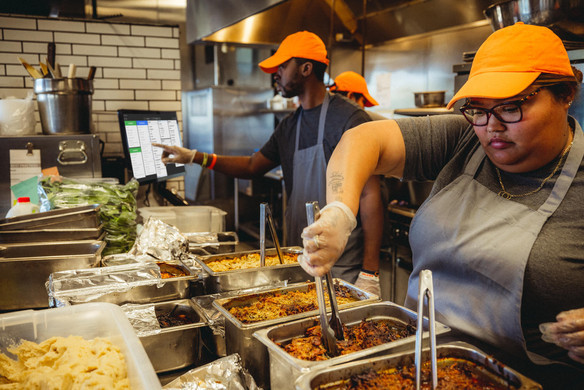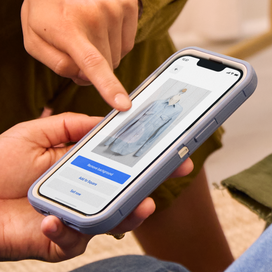Table of contents
Artificial intelligence technology is making waves across industries for its ability to learn, analyze data, make predictions, and generate text. And the food and beverage space is no exception. Nation’s Restaurant News recently declared AI to be the biggest tech trend in quick-service restaurants, highlighting quick-service and fast-food chains’ use of AI-powered tools both behind the scenes and directly with guests.
QSRs are using AI tools to detect inventory levels and understand when to restock ingredients. Some are testing generative AI to improve drive-thru experiences for customers. Others are using AI to predict and recommend order counts to product managers, ultimately working to cut back on food waste. Across the board, restaurants are embracing AI for its ability to create frictionless ordering experiences and ease workloads for staff.
Despite this growing trend, every restaurant is different, and an AI application that works well for one restaurant may not be as well suited for another. AI is still evolving in the food and beverage sector. By understanding the ways you can use this technology at your restaurant today, you can determine what’s best for your business goals.
Where AI can plug into your restaurant operations
Whether at a full-service, quick-service, or fast-casual restaurant, kitchen operations can be incredibly hectic. Your crew likely juggles stocking items, fulfilling orders from various entry points, and expediting dishes before they reach guests’ hands. Beyond that, added responsibilities like making changes to your menu, communicating with your team, and responding to your customers quickly across channels all add up.
Here are six ways AI applications can help your team infuse more organization, efficiency, and personalization into daily operations, as well as direct insights from restaurant operators who currently use it.
1. Organizing incoming orders
For quick-service restaurants especially, orders come in from all angles — the counter, online, via drive-thru. Not only can this overwhelm your kitchen crew, but it can also delay the time it takes to process orders overall. Alexis Furkioti, co-owner of Utah’s quick-service restaurant Pretty Bird Kitchen, told Square, “I’ve been to a lot of restaurants where they do online ordering or use third-party delivery services, and due to unstreamlined operations, in-person guests end up getting prioritized less.”
This is where an AI solution can help drive efficiency. In the Square Kitchen Display System, AI technology powers auto-assigning menu items to kitchen categories and station screens, helping make things more visible for staff who are fulfilling incoming orders. Back-of-house managers can edit and save catalogs with just a few clicks. The biggest benefit? Your team can process orders with ease, helping to reduce wait times for guests. Elias Ali, co-owner at BAO Tea House, recently shared, “We’re a quickly growing fast-casual restaurant with multiple locations in the heart of Manhattan. Our kitchen space is small, and our staff needs to move quickly. Square Android KDS helps us with easy-to-tap tickets and instant order details. The performance is great.”
2. Drafting website and social copy
Generative AI can be a fantastic tool if you’re working on your website copy or looking for some social media inspiration. You don’t even need a specialized app for restaurant copywriting. The team at Ice Cream Social, for example, uses ChatGPT to make their copy sparkle. “It does a great job at providing thought starters, at least, that you can take from there and finesse into what can be final social media copy,” owner Mike Weiss said.
Offer up a detailed prompt, and the AI will generate an outcome that you can edit and adjust to fit your voice and tone and the specifics of your restaurant. There are some good rules of thumb to follow when creating a prompt for AI. Be specific and include details important to the outcome, like the audience, the tone, how long the copy should be, and the format it should take. Remember, you can always provide feedback after the first iteration of AI-generated content and ask the AI to refine its output.
A good example prompt to submit to the AI would be: Write a two-to-three-sentence caption for an Instagram post about a cocktail with the ingredients club soda, gin, cranberry juice, rosemary, and lemon juice. Write it in a fun tone for an audience of young adults who enjoy going to dinner with friends at a restaurant with a comfy atmosphere.
You can also use this type of AI for assistance when working on or updating your restaurant’s website. If you use Websites, you can use the built-in AI tool to do exactly this. The website copy generator can help you write copy and optimize it for SEO purposes so your customers can find you easily.
3. Communicating with your team and customers
Generative AI tools can also help restaurant managers quickly draft up important messages to their teams about staffing schedules, new hires, updated holiday hours, and more. In Square Team Communication, for example, the AI generates a message based on the topic, and your team can personalize aspects of the content, including the length and tone.
You can also use this type of tool to quickly reply to your customers. If you already use Square Messages, then you’ve got access to the AI-powered suggested replies feature. Use it to personalize your automated responses to customers with their names so even when AI is responding for you, your customers receive a custom note — something the majority will likely appreciate. In fact, 76% of surveyed customers said that receiving personalized communication from a brand was a key factor in their consideration of that brand.
Before this type of tech was available, responding to each message personally could take your team hours and require them to be constantly available. With AI-powered tools like Square Messages, your team gets their time back without compromising customer service.
4. Writing item inventory descriptions
Writing item description after item description can get tedious, and it takes up a ton of time that you could spend elsewhere on your business. If your restaurant requires a major inventory haul for a new season or uploading new products to your website, it can be especially helpful to use AI to keep the item descriptions fresh.
This can be great for menu item descriptions online or the descriptions of items you sell diners to take home. For example, an AI prompt along the lines of “Write a one-paragraph description of a home-made tomato sauce made from a family recipe” would result in some inspiration to use for a label description of your restaurant’s secret sauce.
5. Quickly generating your restaurant menu
The pressure to constantly come up with new menu ideas can zap creativity. To strengthen your ideas, you can use AI to help with menu generation. By aggregating public information, an AI solution can help you find the most popular menu trends in your region or among your customer base. It can also offer a sample menu for you to tweak based on your preferences. Consider inputting information such as the menu type you’d like to generate — breakfast, brunch, lunch, dinner, or dessert, the type of cuisine your restaurant offers, and any seasonal elements you’d like to account for.
Square Restaurant POS customers do this today with the Square Gen AI Menu Generator. Within minutes, users can generate a complete menu, unblocking any creativity slumps that come with crafting your menu for the first time or making seasonal changes. It can also help get your restaurant up and running faster if you already have a menu and are just setting up your technology, whether it’s your first location or one of many.
6. Food photo editing
Food photography is difficult, and it can get expensive for restaurants, especially if you’re just launching your business or are expanding locations and you have other startup expenses. At the same time, featuring photos of your food can have a huge impact on sales: Online menus with photos garner up to 44% more sales than those without, according to a report from DoorDash.
Using AI for image creation can be a significant cost and time saver. Some AI tools, like Square Photo Studio, can remove real backgrounds and add in AI-generated ones instead. This can be especially helpful for restaurants looking to add photos to an online menu or mix up the images on social media or on their website.
The Square Photo Studio app is free to download and allows users to upload or take an image straight from their phone, select their industry, remove the existing photo background, and then select keywords like “countertop” or “wooden table” to generate new background options.
Staying on the forefront of restaurant innovation
As much as AI-powered tools can help your team, your customers will probably appreciate the efficiency and personalization these tools provide. According to the Square 2024 Consumer Dining Trends Report, a significant percentage of respondents are open to next-generation tech innovations, such as using personalized menus at kiosks based on facial recognition (39%) or voice ordering through a conversational AI chatbot at a drive-thru (38%). By adopting AI solutions where it makes sense for your business early on, you don’t just help your team work smarter, but you also prepare your restaurant to be ready for what’s next.
![]()













